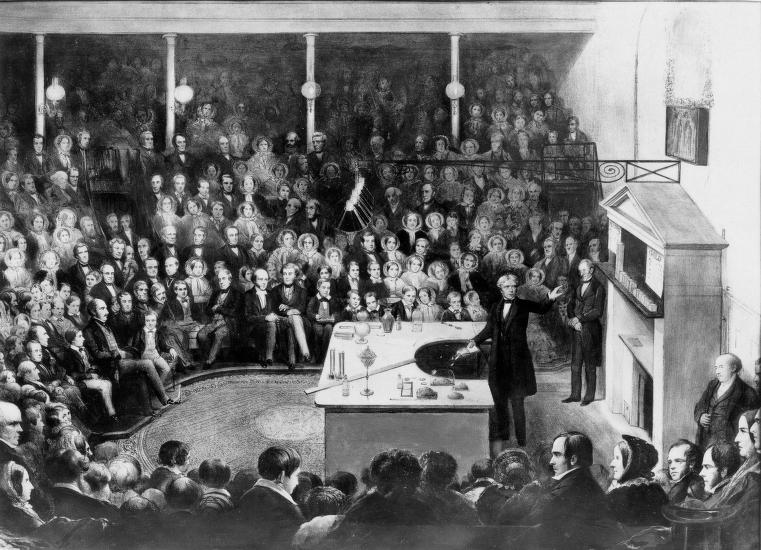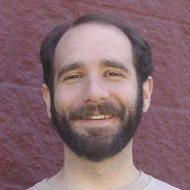Last Sunday's episode of Cosmos nicely weaves together the history of science popularization with the development of a theory of electricity, the theory that makes it possible to disseminate shows like Cosmos so widely.
 This is made easy by the fact that Michael Faraday, a pioneering researcher on electricity, was also one of the seminal science popularizers. Faraday, who grew up with a speech impediment so severe that he wrote about not even being able to pronounce his own name correctly (rendering it “Fawaday”), became famous for his public demonstrations of science, as well as for developing the idea of an electrical or magnetic field. Faraday, the first Fullerian Professor of Chemistry at the Royal Institution, launched the Institute’s series of Friday Evening Discourses and a series of Christmas Lectures for Children. That series continues today, broadcast on television thanks to our understanding of electrical fields (and magnetism and light) as first described by Faraday and systematized by his student Maxwell (also profiled in this episode). Those lectures take us back to a day when people flooded out in an evening to see a man on stage turn on an electrical light, when science was the best entertainment anyone could want.
This is made easy by the fact that Michael Faraday, a pioneering researcher on electricity, was also one of the seminal science popularizers. Faraday, who grew up with a speech impediment so severe that he wrote about not even being able to pronounce his own name correctly (rendering it “Fawaday”), became famous for his public demonstrations of science, as well as for developing the idea of an electrical or magnetic field. Faraday, the first Fullerian Professor of Chemistry at the Royal Institution, launched the Institute’s series of Friday Evening Discourses and a series of Christmas Lectures for Children. That series continues today, broadcast on television thanks to our understanding of electrical fields (and magnetism and light) as first described by Faraday and systematized by his student Maxwell (also profiled in this episode). Those lectures take us back to a day when people flooded out in an evening to see a man on stage turn on an electrical light, when science was the best entertainment anyone could want.
Faraday was also, as Neil deGrasse Tyson notes, a deeply religious man, a member of what Richard Holmes describes as “a rare sect of Biblical fundamentalists…puritan and unworldly in outlook, but with a strong sense of public duty and service.” That religious faith was no small part of what made him a scientist and a popularizer of science. Holmes, in his marvelous The Age of Wonder explains:
For many Romantic scientists, with a robust intellectual belief in the ‘argument by Design’, there was no immediate contradiction between religion and science: rather the opposite. Science was a gift of God or Providence to mankind, and its purpose was to reveal the wonders of His design. This indeed was the essence of ‘natural religion‘, as promoted for example by William Paley in his Natural Theology (1802), with its famous analogy with the divine watchmaker. It was the faith that brought Mungo Park back alive from his first Niger expedition. It was the faith that inspired Michael Faraday to become a Deacon in the Sandemanian Church in July 1832 [a year before he was named Fullerian Professor].
Cosmos glides past this aspect of Faraday’s life, noting that his “fundamentalist Christian faith…would always remain a source of strength, comfort and humility for him,” and adding later that he “believed in the unity of nature.” This lack of emphasis is minor, but still unfortunate, since he stands as another great example of rigorous scientists who see a unity between their scientific and religious work. Faraday stands as an important example for religious members of the Cosmos audience who might worry about the idea of a conflict between science and religion.
Faraday worked at a time when battles over the relationship of science and religion were no less fraught than our own. Holmes notes, immediately after the passage above:
But public faith often differed from private beliefs. Whatever he said in his famous lectures, Davy’s poetry and his posthumous writings…suggested a kind of science mysticism that certainly precluded a Christian God, and possibly even any kind of Creator at all. Others, like William Herschel, had been content to rely on an instinctive, perhaps deliberately unexamined, belief in a benign Creator somewhere distantly behind the great unfolding scheme of nature. Though in Herschel’s case, his own observations had shown how extremely—appallingly—distant, both in time and space, that Creator must be. Moreover, his sister Caroline never once mentioned God anywhere in her journals.
The term “scientist” itself became embroiled in this tension. At a meeting of the British Association for the Advancement of Science, William Whewell offered “scientist” as a way to describe the then-unnamed class of people who work “in the real sciences.” Whewell wrote that he “proposed that, by analogy with ‘artist,’ they might form ‘scientist’—and added that there could be no scruple to this term since we already have such words as ‘economist’ and ‘atheist’—but this was not generally palatable.”
Holmes explains that “the analogy with ‘atheist’ was of course fatal,” at least in 1834. Nonetheless, within a decade, the term was in wide use, with Adam Sedgwick (who had derided the term at first) exalting that “Such a coinage has always taken place at the great epochs of discovery: like the medals that are struck at the beginning of a new reign.” Bernard Lightman, in his Victorian Popularizers of Science, describes how popular interest in science broadened that revolution: “At the beginning of the nineteenth century, the dominant, though by no means universally accepted, worldview was legitimized by Christian modes of thought. it was tied to the old world order and reflected its pastoral, agrarian, and aristocratic nature. By the end of the century, British society had been profoundly transformed, and the worldview of the old order no longer seemed relevant to many members of the intellectual elite, the middle classes, and the working classes. To those who were dissatisfied with traditional beliefs, scientific modes of thought seemed to offer the glue holding together a new worldview far more relevant for living in an urban, industrialized, and middle-class society.”
As Tyson explains in last Sunday's Cosmos, that new epoch was, in no small part, ushered in by Michael Faraday. He did that both by bringing electrical force within human command, inventing dynamos that laid the foundation for modern generators and motors invented by Tesla and Edison, and by developing a comprehensive theory of electricity and magnetism, on which Einstein and other unifiers of physics could build.
But Faraday’s application of his Sandemanian “sense of public duty and service” was also crucial, and remains contentious nearly two centuries later. Cosmos originator Carl Sagan’s bid to join the US National Academy of Sciences was scotched by his fellow scientists, who claimed that Sagan was too much a popularizer to belong to that august body of scientists (claiming that popularization was “symptomatic of an inadequacy in doing science”). Faraday’s own membership in the British equivalent—the Royal Society—was delayed because Faraday’s mentor Humphrey Davy (president of the Society) feared that Faraday’s fame outshone his own. That tradition of popularization also explains the origins of the Science League of America: Maynard Shipley announced the founding of the League at the end of one of his science lectures in San Francisco, and those lectures, his writings, and his work on radio furnished his salary as he fought the battle against creationism in the 1920s. And today, science popularizers like Neil deGrasse Tyson, Neil Shubin, Michael Mann, and Richard Alley are at the forefront of efforts to fight science denial. They may take abuse for it, and it may affect their careers or how their colleagues see them (though I think such negative perceptions are in decline), but it’s vital work that does endless good for society.

